Mars (Martis)
1998.07.23
Mars, who, as father of Romulus, was the primogenitor of the Roman people, the god of war, of husbandry, of shepards, and seers. For him was named the month of Martius, March, the beginning of the Roman year
The Campus Martius (Campo Marzio) is the Roman field named for Mars, the god of war, who, through his son Romulus, initiated the origin of Rome. The Ara Martis, the altar to Mars erected by Romulus, was the first structure within the Campus, and thus signaled the dedication of the Campus to Mars. Additionally, the Equiria, the annual horse-races instituted by Romulus in honor of Mars, were also held within the Campus Martius.
It is precisely the military character of Mars, as well as his status as primogenitor of the Roman people, that Piranesi promulgates throughout the Ichnographia. The large plan contains the Ara Martis in front of a Templum Martis, a second Templum Martis with an Area Martis in front of it, and a designation of the Equiria race course occurs as well.
The Ara Martis, situated within the Campus Martius proper, represents the original altar to Mars, and thus fittingly becomes the centerpiece and focal point of an elaborate circular architectural composition which includes a temple to Mars, a Porticus Praebentes umbraculum diei ab aesti (a porticus providing shade from the heat of the day), and the Domus Alexandri Severi (the imperial residence of Alexander Severus). Furthermore, a large circular pool around the altar of Mars not only sets it apart, but also adds distinction by making it "untouchable" as well. Judging by its surroundings and it pivotal position, Piranesi's delineation of the Ara Martis clearly indicates a very special place.
| |
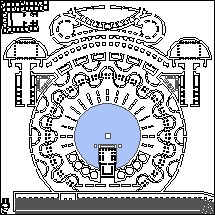
The Ara Martis is first surrounded by a circular pool, and then by a Templum Martis (bottom), a shady porticus (left, right), and the imperial residence of Alexander Severus (above).
|
The second temple of Mars, positioned on the west side of the Tiber at the foot of the Vatican Hill, sits within a hexagonal area labeled Apparatorium Triumphatorum -- the place of preparation for the triumphal march. In front of the temple and place of preparation is the decagonal Area Martis, which an euripus (canal/moat) encloses on two sides, and it is here that Piranesi indicates the beginning of the Triumphal Way. Besides the obvious ceremonial importance of the Area Martis, this place is also distinct within the Ichnographia: its ten-sided perimeter is the only such shape throughout the entire large plan. Significant also is the plan of the Templum Martis, whose ichnography resembles male genitalia. The deliberate connection between Mars and overt masculinity is unquestionable. Moreover, the Templum Martis, the Area Martis, and the beginning of the Triumphal Way together establish a principal axis, one of the three major axes present within the Ichnographia. This axis extends from the top of the Vatican Hill straight down to the bank of the Tiber across from the tomb of Augustus, and is not only great in length, but also rich in symbolism. Represented here is the mighty thrust of Mars, the dominance of Romulus, and hence the source of Rome and its unparalleled pride.
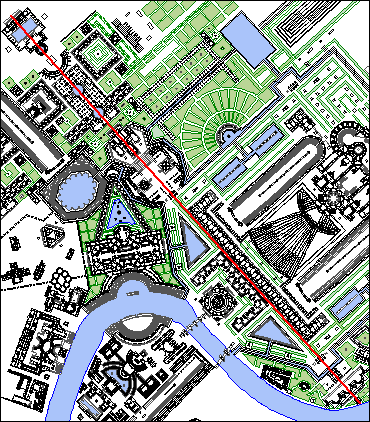
| |
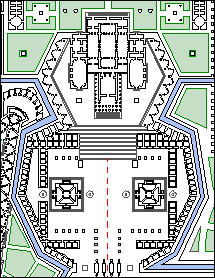
The Templum Martis (top) is surrounded by a hexagonal place reserved for the preparation of the triumphal march. The Area Martis (below) is a large space in front of the Templum Martis and the place where the Triumphal Way begins (indicated in red).
The long axis running through the Templum and Area Martis (center) extends from the Nympheum Neronis atop the Vatican Hill (upper left) down to another Nymphaeum on the west bank of the Tiber (lower right).
|
Another of the Ichnographia's three major axes is the race course of the Equiria, the annual horse races held in honor of Mars. Piranesi delineates the course as a relatively straight path running the length of the Ichnographia's northern sector, beginning in the south at the Petronia Amnis (which is, however, incorrectly placed within the plan) and ultimately reaching the outskirts of Rome at the plan's edge. With the exception of a few private gardens on a hill overlooking the Equiria, all the structures along the course relate directly to the Equiria or to the military in general. Three long porticos, the Porticus a S.P.Q.R. Amoenitati Dicata, the Porticus Vipsania, and the Porticus Alexandri Severi, line the course, and no doubt are meant to accommodate the spectators of Rome's premier "fest". The buildings and areas related to the military include, the Officinae Balistarium (manufactory of ballista), Officinae Scorpiorum (manufactory of scorpions), the Naumachia Domitiani (a large amphitheater designed for the show of mock naval battles), three Circulus (large circular areas for military drills and exercises, and finally the Officinae Armorum and the Officinae machinarum militarium (manufactories of military arms and machines). Not only do these buildings pay respect to Mars as the god of war, but, as a cohesive group, they essentially constitute Rome's "Department of Defense".
| |
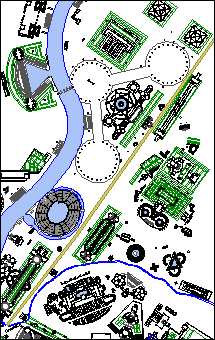
The Equiria (the broad gold line running from the lower left corner to the upper right corner) spans the Ichnographia's northern region, and the course itself runs in an almost true north-south direction.
|
Aedes Vulcani
Officinae Armorum
Officinae machinarum militarium
1998.12.01
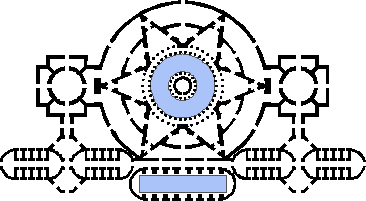
The military machine complex of the Aedes Vulcani, the Officinae Armorum, and the Officinae Machinarum Militarium, which Piranesi postions near the north end of the Equiria, is both literally and figuratively the star of the Equiria's overall military program. This group of buildings represents the manufacturing headquarter's of ancient Rome's armed forces. It is thus a center of civic pride as well as a tribute to Mars, and its placement along the Equiria is entirely fitting, even though the whole design is without historical or archeological substantiality.
| |
In the center of the Officinae machinarum militarium is the Aedes Vulcani, a small circular temple or shrine surrounded by a circular pool of water and dedicated to the god of fire. The Officinae machinarum militarium itself is a six pointed star shaped plan within a circular perimeter wall, with two small cruciform wings at either end. The Officinae Armorum is essentially four sets of linear celled buildings divided into pairs with a long pool building inbetween. Together, the three buildings comprise a bi-laterally symmetrical composition whose many openings create a complex of abundant connectivity.
On a purely figurative level, the complex's plan resembles a military insignia of honor.
|
| |
Alexander Severus
1998.08.09
Alexander Severus... ...two of the buildings within the Ichnographia--Domus Alexandri Severi and Porticus Alexandri Severi--have a close connection to Mars. The Domus Alexandri Severi is part of the compound enclosing the original altar of Mars, and the Porticus is the last building along the Equiria.
...it is interesting to note that Alexander Severus had considered dedicating a temple to Jesus, and that the military under his reign suffered significant losses. ...willing to propose that Piranesi uses (the buildings of) Alexander Severus as signifying the beginning of the end. If this is so, Piranesi is especially clever because he associates the beginning of the end directly with the Campo Marzio's true beginnings. Furthermore, Alexander Severus then signifies the beginning of the pagan-Christian inversion. ...there are even inversion motifs evident in the porticus around the altar of Mars and the porticus at the end of the Equiria.
Tafuri, Manfredo
1998.11.16
After an extended independent analysis of the Ichnographia Campus Martius, it becomes evident that Tafuri misreads Piranesi's large plan in most cases. Tafuri's text indicates no research of the plan beyond simply looking at it and subsequently offering a description of what Tafuri thinks he sees. (In fact, a careful reading of both Tafuri's texts and the text of Fasolo from 1956, clearly shows that Fasolo's text greatly influenced Tafuri's observations.) For example, in calling out the various axes of the Campo Marzio, Tafuri notes the axis running through Hadrian's Tomb, but he fails to recognize it's symbolic function as the Axis of Death; nor does he identify the Axis of Life that runs perpendicular to the Axis of Death. Moreover, Tafuri marginally notes the semblance of an axis within the northeast sector of the plan, yet he never mentions that Piranesi labeled this axis the Equiria, place of the annual horse races instituted by Romulus in honor of Mars.
These are just two examples which plainly demonstrate that Piranesi's plan holds significant and coherent symbolic content, however, recognition of Piranesi's "carved in stone" symbolism necessarily negates Tafuri's primary thesis that the Ichnographiam Campi Martii is utterly fragmented and devoid of "language." Ironically, had Tafuri not discounted the presence of language and instead actually translated the hundreds of Latin labels Piranesi applies throughout the plan, he would have concluded with a more accurate, if not also a more honest reading.
It is truly unfortunate that the subsequent 20th century Campo Marzio analyses of Allen, Bloomer, and Eisenman, build upon Tafuri's mistakes rather than correct them.
Equiria
1998.12.01
According to Festus, it was Romulus who instituted the first horse-races in honor of Mars. These races became an annual event, and, due to their origin, are rightly considered the "proto" festival or feast of Roman tradition. According to Varro, the races took on the name of Equirria, which is derived "from the equorum cursus 'running of horses'; for on that day they currunt 'run' races in the sports on the Campus Martius." Furthermore, Ovid's Fasti lists the dates of the races as the 27th of February and the 14th of March, and, since the Roman calendar began the 1st of March, the holding of the first horse-race the day just before the new year further attests the Equirria's premire "fest" position.
eros et thanatos
2683a
2683c
1999.01.29
27 February - the 1st Equiria
1999.02.27 17:24
The Equria is the annual horse-races held on the 27th of February and the 14th of March in the Campus Martius, in honor of Mars.
It rocked Eisenman on his chair...
2007.11.09 10:56
Giovanni Battista Piranesi died today in 1778, on the feast of the dedication of the Basilica Constantiniani (known today as the Basilica of St. John Lateran), the first Christian basilica in Rome.
"Piranesi uses the Rome that was extent in the eighteenth century as a starting point, but that possesses no original value; it is merely a being in the present. From this existential moment of being, he takes buildings that existed in the first and second centuries, in Imperial Rome, and places them in the same framework of time and space as the eighteenth-century city."
--Peter Eisenman, "Notations of Affect. An Architecture of Memory" in Pathos, Affect, Gefühl (Berlin: Walter de Gruyter GmbH, 2004), pp.504-11.
If you actually study the Campo Marzio you'll find the starting point, framework and the millennium's worth of buildings that Piranesi utilized. First there are the altar and race course dedicated to Mars by Romulus in the mid-eighth century BC. Incidentally, this is how the Campo Marzio received its name--the fields of Mars. And to manifest the framework there is the last Imperial artifact of the Campo Marzio, the sepulcher of Empress Maria, wife of Honorius, from the early 5th century AD. Indeed the sarcophagus of Empress Maria holds a key position within the Il Campo Marzio publication. And to complete the framework, the last page of Il Campo Marzio depicts a double theater.
|